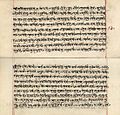Sanskrit facts for kids
Quick facts for kids Sanskrit |
||||
|---|---|---|---|---|
| संस्कृतम् saṃskṛtam | ||||

The word Sanskrit (संस्कृतम्) written in Devanagari.
|
||||
| Region | South Asia | |||
| Native speakers | 14,000 (2001) | |||
| Language family |
Indo Aryan
|
|||
| Writing system | No native script. Written in Devanagari, various Brāhmī-based. |
|||
| Official status | ||||
| Official language in | one of the 22 scheduled languages of India |
|||
|
|
||||
Sanskrit is a very old language from India. It is important for three major religions: Hinduism, Buddhism, and Jainism. Many other Indian languages grew from Sanskrit. Today, about 14,000 people in India speak Sanskrit every day. It is one of India's 22 official languages. It is also an official language in the state of Uttarakhand.
Sanskrit is a special type of Old Indo-Aryan language. Its roots go back to a language called Proto-Indo-European. Some people believe that the Indo-Aryans moved from Central Asia to South Asia around 2000 BC. They brought their languages, including early forms of Sanskrit, with them.
The main way to write Sanskrit is using the Devanagari script. But it can also be written using other Indian scripts. Sometimes, people even write Sanskrit using the Latin alphabet.
Contents
Understanding Sanskrit's History
In the 1700s, a judge named William Jones worked in India. He studied Sanskrit and noticed something amazing. Sanskrit was similar to Latin and Greek. This discovery helped people understand how languages are connected around the world.
What Is Sanskrit Used For?
Sanskrit has a rich history of literature. This includes beautiful poetry and exciting drama. There are also many scientific, technical, and philosophical texts. Important religious writings are also in Sanskrit.
Today, Sanskrit is still used in many ways. It is a ceremonial language in Hindu religious events. It is also used in Buddhist practices. You can hear it in hymns and chants.
Sanskrit Grammar: A Closer Look
Sanskrit has a very detailed grammar. It uses eight different grammatical cases. These cases show the role of a word in a sentence. The language also has three grammatical genders. These are masculine, feminine, and neuter. It also has three grammatical numbers: singular, dual, and plural. This complex system makes Sanskrit very precise.
Images for kids
-
Rigveda (padapatha) manuscript in Devanagari, early 19th century. The red horizontal and vertical lines mark low and high pitch changes for chanting.
-
The Spitzer Manuscript is dated to about the 2nd century CE (above: folio 383 fragment). Discovered in the Kizil Caves, near the northern branch of the Central Asian Silk Route in northwest China, it is the oldest Sanskrit philosophical manuscript known so far.
-
A 5th-century Sanskrit inscription discovered in Java, Indonesia—one of the earliest in southeast Asia after the Mulavarman inscription discovered in Kutai, eastern Borneo. The Ciaruteun inscription combines two writing scripts and compares the king to the Hindu god Vishnu. It provides a terminus ad quem to the presence of Hinduism in the Indonesian islands. The oldest southeast Asian Sanskrit inscription—called the Vo Canh inscription—so far discovered is near Nha Trang, Vietnam, and it is dated to the late 4th century to early 5th century CE.
-
One of the oldest surviving Sanskrit manuscript pages in Gupta script (c. 828 CE), discovered in Nepal
-
The ancient Yūpa inscription (one of the earliest and oldest Sanskrit texts written in ancient Indonesia) dating back to the 4th century CE written by Brahmins under the rule of King Mulawarman of the Kutai Martadipura Kingdom located in eastern Borneo
-
Sanskrit festival at Pramati Hillview Academy, Mysore, India
See also
 In Spanish: Sánscrito para niños
In Spanish: Sánscrito para niños











